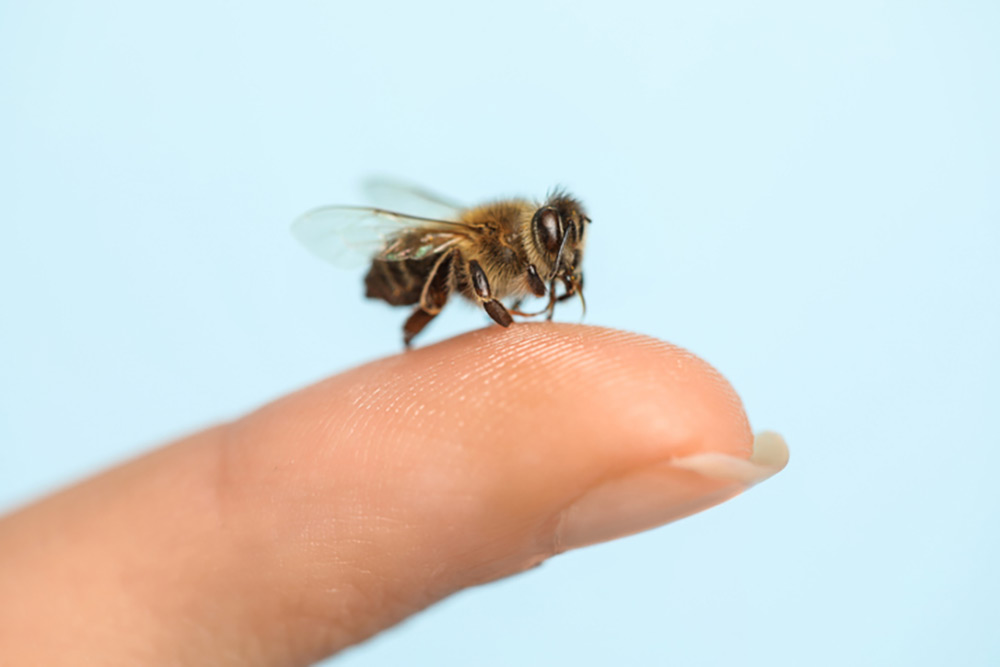
iStock
By Mary Carpenter
IN GREY BEES, a recent novel by Ukrainian writer Andrey Kurkov, a bee-bed “with hundreds of thousands of bees beneath it” belongs to a fictional beekeeper living without electricity or neighbors in the “grey zone” between Ukraine and Russia. After the bee-bed attracted an important visitor—a former Governor and boss of Donbas, who paid the beekeeper huge sums of money along with a bottle of vodka and a hug—“people were now advertising bee-beds in every district centre [but] the first bee-bed remained the most popular, because no one else had ‘the governor’s bees.’”
People are discovering the therapeutic value of bees, and while a few spa bee beds have popped up around the U.S—such as one at the Savannah Bee Company —some people are also constructing their own. Posting build-your-own directions, Leo Sharashkin writes: “I call it Bed-and-Bees or B&B and it is a long horizontal hive where you are separated from the bees by thin planks and can bathe in their warmth and vibration and smells without any danger of being stung… you experience how relaxing and soothing and healing it is.”
Apitherapy usually refers to bee venom treatment (BVT), which made news during the pandemic when more than 5,000 beekeepers in a Chinese survey appeared immune to Covid infection. Along with the storied protection of beekeepers from a wide array of infections, bee venom has helped relieve joint pain caused by both rheumatoid and osteoarthritis and autoimmune diseases, such as multiple sclerosis (MS). According to the theory, bee venom, or apitoxin, causes irritation and inflammation as part of an allergic reaction—revving-up the immune system, which makes it better at fighting infection.
Among active components in bee venom—enzymes, amino acids, hyaluronidase—the most active in fighting infection may be the peptide melittin, the most toxic compound in bee venom that can “induce wide anti-inflammatory effects,” according to an article by researchers in France and Lebanon. In laboratory studies, melittin has protected mice exposed to “lethal doses of influenza A H1N1 virus.”
Most symptoms—commonly, pain, fatigue, and cognitive problems— allegedly benefiting from BVT rely on self-reporting by sufferers—as does relief and other improvements for which it is credited. The powerful placebo effect may play a significant role in these benefits, but conventional, rigorous scientific methods have failed to document measurable improvements. Extensive reviews of studies on MS patients concluded that bee venom was ineffective; and one study in the Netherlands on 24 MS patients found “no beneficial effects” evident on MRIs, and participants reported “no improvement in their disability, fatigue or quality of life.”
Renewed interest in bee venom therapy came from a 2016 episode of the Netflix series “(Un)Well” that portrayed enthusiasts of its use both in anti-aging creams and in treatments using direct stings from bees. The episode follows a young woman who reports suffering for years from undiagnosed Lyme disease, as she receives treatment at California-based Heal Hive— where bees are held against her back using tweezers until each one stings and ejects its venom.
Chronic Lyme symptoms—cognitive impairment, fatigue, and vision and other complaints—may persist when Lyme bacteria, Borrelia, remains in the body at levels undetectable by medical testing, as well as inaccessible to antibiotic treatment. Laboratory studies at the University of New Haven showed “significant effects” of bee venom on the bacteria compared to those of antibiotics. Among 40 patients with enduring Lyme symptoms who received BVT in a study published in the Journal of Clinical and Cellular Immunology, two recovered fully after 2.5 years; 8 recovered 85-90% after one year; and the rest showed lessening of symptoms.
“Bee venom acupuncture” (BVA) involves injections of venom at acupuncture points relevant to specific symptoms or diseases—with the idea of adding healing effects of the venom to the mechanical benefits of acupuncture stimulation. And homeopathic preparations such as Apis mellifica employ the entire bee—ground-up and added to a solution that is then diluted to such a degree that “so many times …we are only eating the idea and the energy of the bee,” according to Healthy With Honey.
But killing honeybees—whether using the whole bee or the venom—is a major concern with apitherapy, because these bees contribute to about 80% of the pollination of flowers, fruits and vegetables, and populations have declined dramatically in recent years. Whether venom is obtained directly from a stinging bee or extracted using an electric stimulus and then injected, the bee dies within 18 to 114 hours. (Venom from wasps, in the same order as bees, contains many of the same compounds, but not melittin.)
Apitherapy products that do not require killing the bees include royal jelly—a milky substance fed to bee larvae that could develop into the queen bee; pollen—collected in a narrow trap that removes pollen as bees return to the hive; propolis—a resin-like material, dubbed “bee glue,” collected by the bees from trees to use in creating and repairing hives; and beeswax—produced by bees’ bodies and combined with honey to create combs for hives.
“A new tool in the search for new ways to prevent infection with Covid-19” was the description of BVT by entomologist Norman Gary at a Covid-19 symposium hosted by UCDavis, a center for honeybee therapy research. Gary, “known internationally as “The Bee Man,” holds two Guinness World records: one for holding 109 bees inside his closed mouth for 10 seconds; and the other for creating the “bee suit,” a cluster of “more than 87 pounds of bees on a friend.”
“For an alternate explanation of the lower rates of beekeepers’ susceptibility to Covid and other infections, however, these researchers referred to a study on beekeeper personalities—which can combine two “archetypes:” “social” and, the more dominant, “predominantly investigative individuals, which means that they are quite inquisitive and curious people that often like to spend time alone with their thoughts.”
—Mary Carpenter regularly reports on topical subjects in health and medicine.
.

